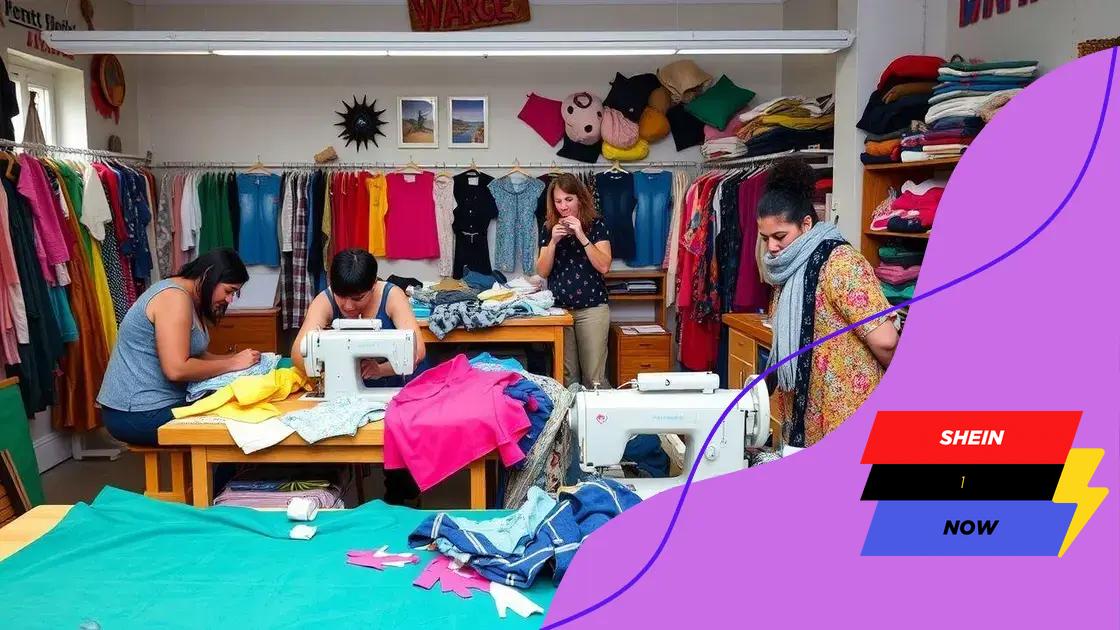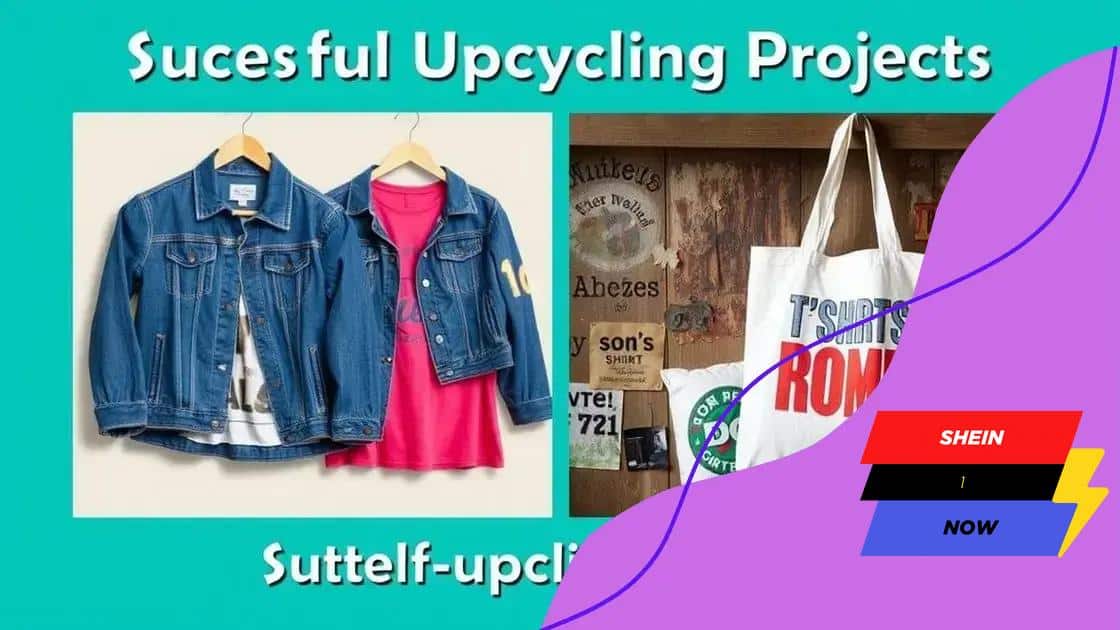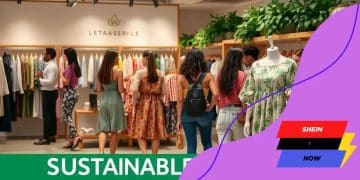Shein’s initiatives for teaching upcycling to fashion lovers

Shein’s initiatives for teaching upcycling focus on promoting sustainable fashion by offering workshops and educational programs that inspire creativity and responsible consumption among consumers.
Shein’s initiatives for teaching upcycling play a pivotal role in encouraging sustainable fashion practices. Have you ever thought about how reimagining clothing can extend its lifecycle? Let’s dive into the creative ways Shein is transforming the fashion landscape.
Understanding upcycling in fashion
Understanding upcycling in fashion is essential for anyone interested in sustainable practices. This concept involves taking used or discarded materials and transforming them into something new and beautiful. It not only helps reduce waste but also encourages creativity in how we view fashion.
What is Upcycling?
At its core, upcycling is about giving new life to items that would otherwise be thrown away. Instead of contributing to the landfill, upcycling allows us to change our perspective on old clothes.
Benefits of Upcycling in Fashion
There are many benefits to embracing upcycling:
- Promotes sustainability by reducing waste.
- Encourages creative thinking and innovation.
- Supports local artisans and small businesses.
By participating in upcycling, consumers play a crucial role in promoting a more sustainable fashion industry.
Moreover, understanding the upcycling process helps develop a deeper appreciation for the craftsmanship involved in creating unique pieces. This awareness can inspire others to take action, whether it’s through sewing, designing, or even just shopping mindfully.
As more people learn about upcycling, we can expect a significant shift in the fashion landscape. By valuing our resources and being conscious of our consumption, we pave the way for a greener future in fashion.
Shein’s workshops and educational programs
Shein’s workshops and educational programs are crucial in fostering a culture of upcycling within the fashion community. These initiatives not only teach valuable skills but also inspire participants to be more sustainable in their fashion choices.
Types of Workshops Offered
Shein offers various workshops that cater to different skill levels and interests. Some of the popular topics include:
- Introduction to Upcycling: Learn the basics of transforming old clothes.
- Creative Sewing Techniques: Discover unique ways to stitch and embellish.
- Fashion Design Essentials: Understand the principles of designing sustainable fashion pieces.
These workshops create a space where participants can express their creativity while learning practical skills.
In addition to hands-on experiences, Shein’s educational programs often include online resources, such as tutorials and guides. These materials are designed to be user-friendly, making it easy for anyone to get involved in upcycling.
Furthermore, Shein collaborates with local artists and designers to lead special sessions. This not only enhances the learning experience but also supports local talent. Each workshop provides valuable insights into the sustainable fashion movement, making participants feel connected to the larger community.
By participating in these workshops, attendees not only learn about upcycling but also become advocates for change. They leave with the knowledge and inspiration to make a difference in their own lives and the fashion industry as a whole.
Real-life examples of upcycling success

Real-life examples of upcycling success showcase how creativity can transform waste into valuable fashion pieces. These stories inspire others to embrace the concept of sustainability through innovative thinking.
Case Study 1: The Denim Jacket
One notable example involves a designer who took old denim jeans and turned them into stylish jackets. By cutting and sewing the fabric into new shapes, the designer created unique pieces that are both fashionable and environmentally friendly. This approach not only reduces waste but also gives a fresh look to an already popular fabric.
Case Study 2: T-shirt Transformations
Another inspiring story features a small business that specializes in transforming graphic t-shirts into tote bags. By using techniques like cutting and stitching, these everyday items receive a new purpose. This transformation highlights the importance of reimagining materials we often overlook.
- Promoting sustainable fashion through practical examples.
- Encouraging creativity in everyday clothing.
- Highlighting the effectiveness of upcycling in reducing waste.
These real-life examples convey a strong message about the power of upcycling. They demonstrate how anyone can make a difference by changing their approach to fashion. By embracing upcycling, we can help reduce the environmental impact of our clothing choices.
As more people share their success stories, the movement gains momentum. It encourages a shift in mindset about fashion consumption and sustainability.
Impact on sustainability and consumer habits
The impact of upcycling on sustainability and consumer habits is profound. As more consumers become aware of environmental issues, they increasingly seek ways to make better choices in fashion.
Shifting Consumer Mindset
Many people are now recognizing the importance of sustainability in their everyday lives. This has led to a change in how they view their clothing choices. Instead of simply buying new items, they are exploring options like upcycling and thrifting.
Benefits of Upcycling for the Environment
Upcycling plays a critical role in reducing waste. By creatively reusing materials, we can:
- Decrease the amount of clothing sent to landfills.
- Reduce the demand for new resources and materials.
- Minimize the carbon footprint associated with clothing production.
Such benefits contribute to a healthier planet and promote a more circular economy.
As the trend of upcycling grows, it encourages industries and brands to rethink their production methods. Companies are starting to incorporate sustainable practices in response to consumer demands. This has led to a rise in brands that focus on eco-friendly materials and processes.
Many consumers feel empowered to make choices that align with their values. They are more likely to support businesses that prioritize sustainability. This shift can influence the entire fashion industry, pushing more companies to adopt responsible practices.
As consumers become vocal about their preferences, the call for sustainable fashion resonates louder. The relationship between upcycling and consumer habits continues to evolve, highlighting the importance of individual action in creating a positive impact on the environment.
Future of upcycling in the fashion industry
The future of upcycling in the fashion industry looks promising as both consumers and brands increasingly recognize its value. This trend is reshaping how clothing is produced and consumed, paving the way for a more sustainable fashion landscape.
Growing Demand for Sustainable Fashion
As awareness about environmental issues rises, the demand for sustainable fashion practices is growing. Consumers are seeking brands that support eco-friendly initiatives. Upcycling offers a unique solution by extending the life of clothing items and minimizing waste.
Innovations in Upcycling Techniques
With advancements in technology, upcycling techniques are becoming more refined:
- Use of digital printing to add unique designs.
- Incorporating 3D printing for intricate details.
- Collaboration with artists for creative pieces.
These innovations not only enhance the creative process but also increase the appeal of upcycled garments.
Moreover, many emerging brands are focused exclusively on upcycling. They are creating entire collections from salvaged materials, showcasing how fashion can be both stylish and sustainable. This shift encourages larger brands to rethink their production methods in favor of more eco-conscious strategies.
Another exciting development is the rise of upcycling workshops and community events. These opportunities allow individuals to learn about sustainable practices and encourage a collective effort towards better consumption habits. As people engage in these activities, they become advocates for the upcycling movement.
The future of the fashion industry hinges on the ongoing commitment to sustainability. Upcycling plays a crucial role in this transformation by inspiring more consumers to adopt eco-friendly practices. As this trend continues, we can anticipate a fashion landscape where creativity and sustainability coexist harmoniously.
FAQ – Frequently Asked Questions about Upcycling in Fashion
What is upcycling in fashion?
Upcycling in fashion involves taking old or discarded clothing and transforming it into new, stylish pieces, promoting sustainability.
How does upcycling benefit the environment?
Upcycling helps reduce landfill waste, minimizes the demand for new resources, and lowers the carbon footprint associated with clothing production.
Can anyone participate in upcycling?
Yes, anyone can participate in upcycling! There are many workshops and resources available to help individuals learn upcycling techniques.
What is the future of upcycling in the fashion industry?
The future of upcycling looks bright as consumer demand for sustainable fashion continues to grow, encouraging brands to adopt eco-friendly practices.





